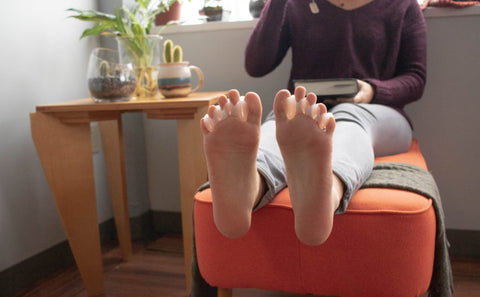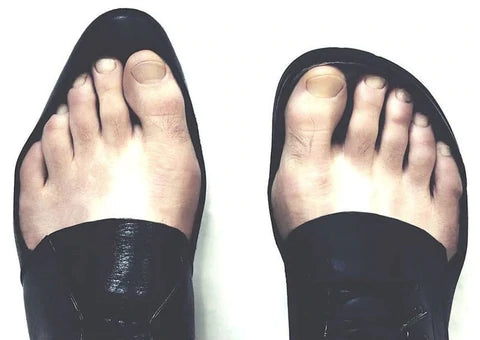With numerous nerve endings, bones, muscles, and joints in each foot, there is no doubt that the feet are capable of a lot more than we give them credit for. Quite literally, they are the foundation for our everyday movement that we often take for granted. Unfortunately, the lack of care and attention feet receive cause the muscles in them to grow weaker, and they become less adaptable over time. This, in turn, affects one’s balance and overall mobility, among other things.
With all of that said, the bottom line is that, if you want healthy, strong, and adaptable feet, then foot function is something you need to prioritise and nurture rather than limit. In this article, we will be helping you learn the best ways to restore natural foot function but first, let’s talk about where it all went wrong.
What Happened to My Natural Foot Function?

Let’s start with the facts; in order for your feet to reach optimal levels of strength, mobility, and adaptability, they require training, movement, and variation, respectively. There is a reason why people who have adopted tribal living are said to be healthier than those with evolved lifestyles; they allow their feet and bodies to develop and adapt as nature intended. In doing so, they reap the benefits of natural foot function.
Now, getting back to what is/has been an inhibiting factor in your foot health journey, let’s start at the beginning. Right from kindergarten and all through highschool, there is a 99.9% chance that the downfall of your foot health began with the wrong school shoes. During this crucial stage of development, traditional school shoes worn by most children have caused havoc in their natural growth and functionality. This leads to dysfunctional adult feet which is owed to many different factors that ultimately fault the design and materials used to make modern-day footwear. To pinpoint these damaging features of conventional shoe designs, narrow toe boxes, rigid soles, excess cushioning, and elevated heels are just a few of them.
Along with this, lack of barefoot activity, sedentary lifestyles, and little to no variation in foot movements have all led to a major disruption in natural foot function. Nevertheless, it’s never too late to start working on the restoration of your foot function, and improve your overall foot health; however, with that said, the longer you wait, the greater the challenge. Worst of all, you will be prolonging foot pain, foot disorders, and discomfort that you are experiencing at present. This is in addition to also putting yourself at a higher risk of falling (due to balance issues) and potential injuries. So, what do you do about this? Read on to find out.
How to Restore Natural Foot Function
With a change of environment and some basic training, your feet can do a complete 180 and go from dysfunctional to naturally functional once again. Of course, like everything else, achieving this goal requires some work and consistency.
So, without further ado, here are 5 simple ways to restore natural foot function.
1. Work on Your Toes First
You may or may not realise it but narrow shoes alter the shape of your feet and toes. Instead of exhibiting a natural toe splay which sees the big and little toe pointing outward, they are curled inward due to being crushed together from prolonged usage of modern shoes. It should also be noted that misaligned toes affect their natural mobility, decrease stability, and cause bunions, hammertoes, and the likes. A few ways to improve toe function includes performing exercises that involve extending and moving the toes, using toe spacers, and switching to barefoot shoes.
2. Incorporate Balance Training
Individuals with poor balance are more prone to falling and sustaining foot or other injuries. Obviously, working on your balance entails training your feet in new, challenging ways in order to see improvement. There are various balance/coordination activities you can perform which stimulate the muscles in the feet and accelerate mobility of the ankles and joints as well.
3. Switch to Barefoot Shoes
Whether at the workplace, social gatherings, or just about any public space, wearing shoes is often mandatory while for others (or most people), a personal choice. For these reasons, it is absolutely crucial to wear the ‘right’ shoes as opposed to what most fashion trends and established footwear brands are selling you. Barefoot shoes are designed to retain the natural foot shape and function with wide toe boxes, thin and flexible soles, and no heel or toe elevation. In doing away with footwear that is compromising your natural foot function, and transitioning to barefoot shoes, you will immediately be on the right path to healthy feet!
4. Roll Your Feet

The purpose of rolling your feet with the help of a foot roller, mobility ball, or even a tennis ball is to relieve muscle tension or tightness through targeted stimulation. It should be noted that first-timers typically experience a little discomfort, however, it is important to push through it, and increase the pressure overtime to yield the maximum benefits. When the muscle tissue gets used to these new sensations, you will actually start to enjoy the exercise!
5. Practice ‘Barefoot Living’

Ultimately, the goal is to condition your feet to walk and do other activities barefoot without any pain or discomfort - something that is expected because our feet have been overly protected and cushioned by traditional shoes. This is rather unfortunate because, in reality, foot function peaks when we are barefoot. Therefore, the more freedom and exposure your feet have to the ground, the more resilient they will become. Barefoot living also helps in strengthening foot muscles, increasing mobility, and improving balance. To ease into going barefoot as often as possible, start by walking barefoot in your house for at least 10 minutes per day, and gradually increase the time as your feet begin to adjust and adapt to it.
CONCLUSION
Natural foot function is critically important and must be prioritised in order to maintain healthy feet. Our evolved lifestyles and poor choice of ill-fitting shoes over the years have left us with dysfunctional feet that often ache and, subsequently, leads to many different disorders of the feet. To counter this negative progression in your foot health journey, you must incorporate daily exercises and activities that help restore your natural foot function such as balance training, walking barefoot, rolling your feet, working on your toes, and lastly, switching to natural footwear!
DISCLAIMER:
The above content is for educational or informational purposes only and is not intended to replace or augment professional medical instruction, diagnosis, or treatment. Read the full Terms and Conditions & Disclaimer here.








